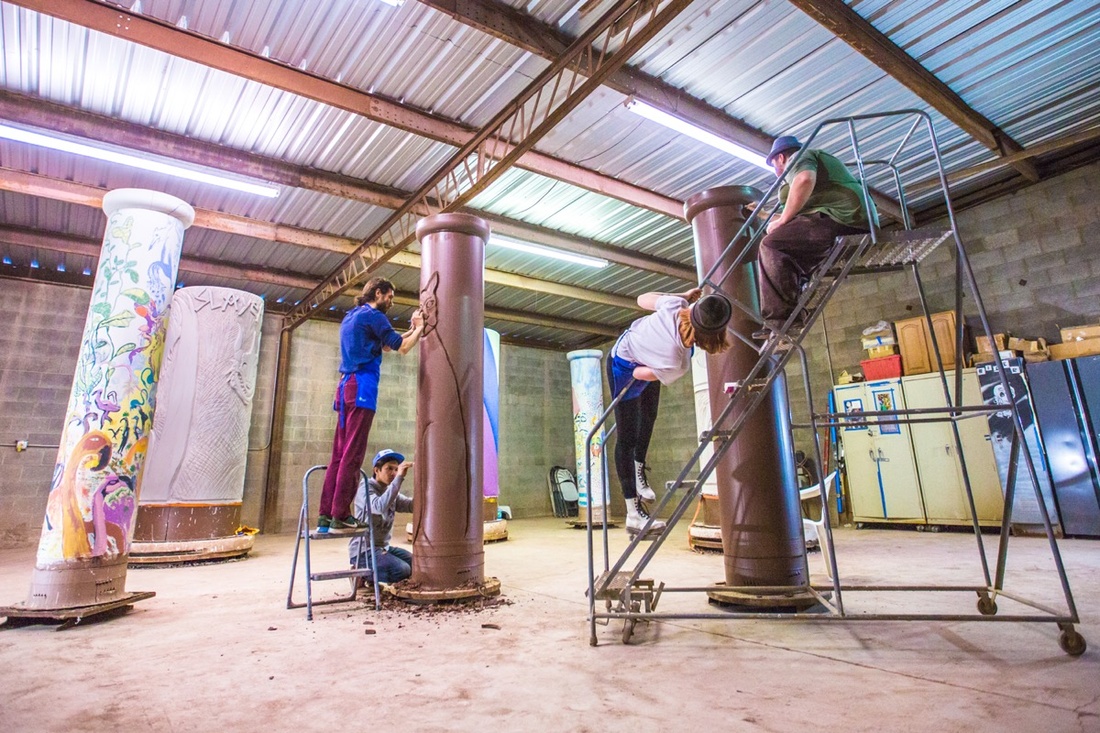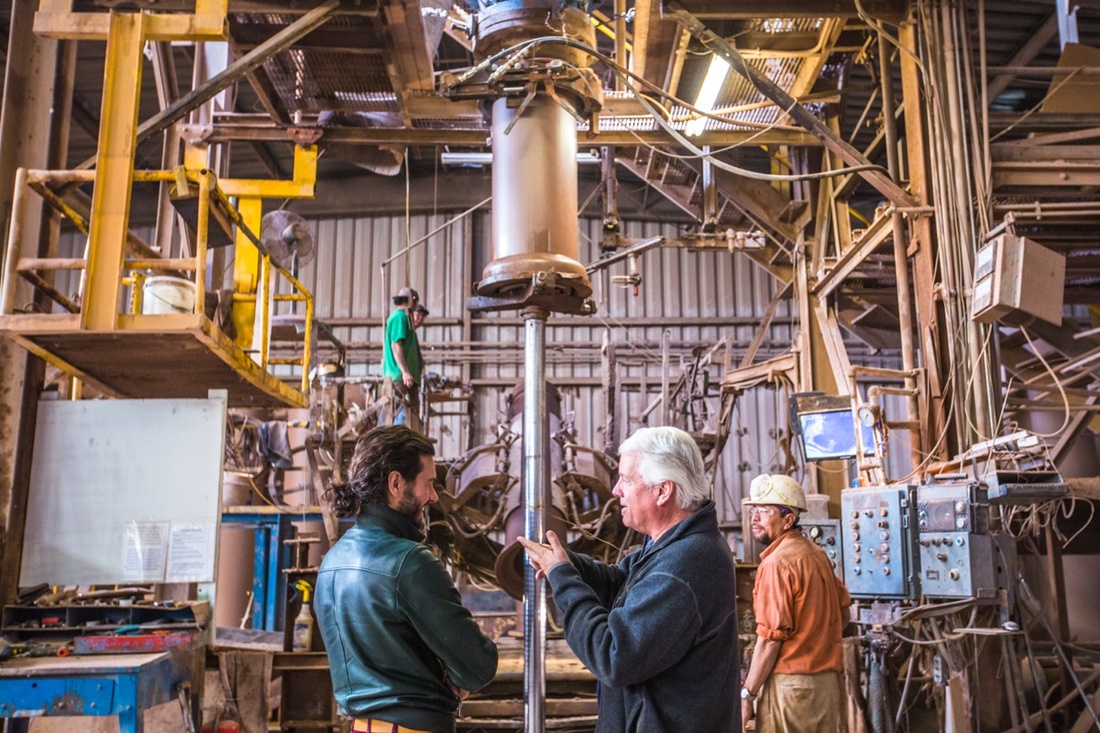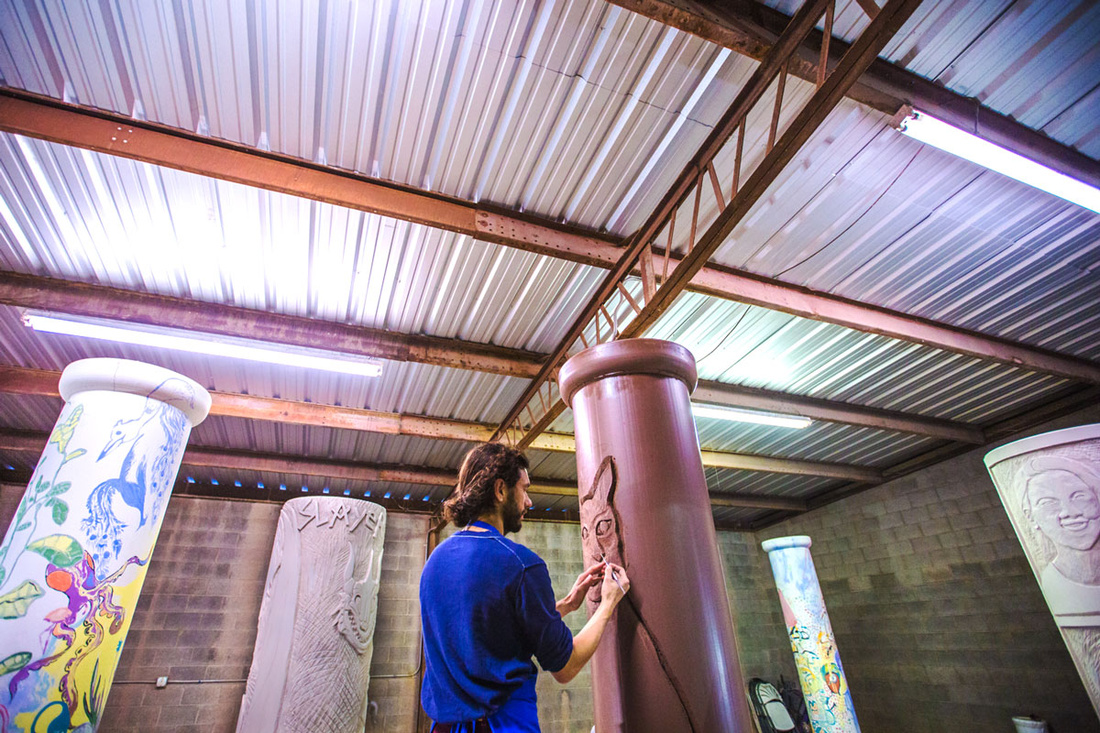The Arizona Pipe Factory That’s a Haven for Ceramic Artists—Including Tom and James Franco
 Firehouse Art Collective Members. Photo by Alex Diana. Courtesy of Metric Cosmetics.
Firehouse Art Collective Members. Photo by Alex Diana. Courtesy of Metric Cosmetics.
An industrial factory that churns out giant clay pipes for municipal sewer systems may seem like an unusual place for artistic experimentation. Yet it’s one such site in Phoenix, Mission Clay Products, where numerous noted ceramic artists have created intriguing and unexpected artworks over the past decade.
Two of the most recent artists to work with Mission Clay’s eight-foot-tall pipes is Tom Franco, a Bay Area artist, and his older brother, actor James Franco. Collaborating on-site in Phoenix and remotely, the Franco brothers worked together to create nine ceramic pillars that have been carved, painted, and fired. The works were then hauled into a gallery for a mostly whimsical, yet oddly attractive exhibition—we’re talking about sewer pipes, after all.
The show, aptly titled “Pipe Brothers: Tom and James Franco,” debuted in mid-June at the nationally known Ceramics Research Center, an arm of Arizona State University in Tempe.
The Franco brothers join an exclusive circle of artists who, over the years, have been invited to work at the pipe-fabrication company, which is tucked into an industrial corner of southwest Phoenix. Mission Clay makes more than 15,000 tons of vitrified clay pipe (VCP) annually, using locally sourced clay. The company originated in California before branching out to Arizona in 2007.
 Photo by Alex Diana. Courtesy of Metric Cosmetics.
Photo by Alex Diana. Courtesy of Metric Cosmetics.
Under the leadership of Bryan Vansell, the company has also nurtured a program called Mission Clay: Art + Industry, which aims to offer an environment to foster artists’ creativity and inspire fresh ideas.
For more than three decades, the company has welcomed artists to share space alongside factory workers, fostering dialogue and engagement between the two groups. In the 1980s, the Art + Industry program even held “Clay Pipe Symposiums”—festive weekend events with guest artists and panel discussions. The lineup included names like Tony Hepburn, Al Johnson, Judy Moonelis, Stephen De Staebler, Christine Federighi, and Ron Nagle. Sculptors Jun Kaneko, Susannah Israel, and Alan Chin also have a long association with Mission Clay.
As for the Franco brothers, the venture into clay pipes sprang from a conversation with John Toki, the noted Bay Area ceramicist and teacher, who has mentored Tom over the years. Tom’s work has typically centered on paintings and found-object assemblages, while James has focused on large-scale paintings.
As Tom recalled in a phone interview, Toki saw the Franco brothers’ work as a natural fit for Mission Clay. The prospect excited the younger Franco, who notes that Toki has a “huge fascination with progressing the ceramic arts.” Toki has long worked with massive proportions of clay in his barn-size studio. Today, he serves as the associate director of Art + Industry.
 Tom Franco and Mission Clay owner Bryan Vansell. Photo by Alex Diana. Courtesy of Metric Cosmetics.
Tom Franco and Mission Clay owner Bryan Vansell. Photo by Alex Diana. Courtesy of Metric Cosmetics.
Tom Franco traveled to Phoenix four times over the course of a year, accompanied by a team of four artists from the Firehouse Art Collective, a Bay Area network of affordable residential/gallery/retail spaces that he helped found. Sometimes working in extremely hot conditions in the vast factory, the team got a taste of the physical energy needed to work with massive towers of wet clay.
The pipes are extruded from a 50-foot-tall machine and then carefully forklifted into the artists’ work area. Franco and fellow artists often worked on ladders, putting muscle into shaping, scraping, and puncturing the clay. The beehive-shape kiln area is bigger than a house, Franco estimates, and the drying, firing, and cooling process can take up to several weeks.
Franco says he tackled the sculptural end of the work with glee, feeling the primal aspects of so much raw clay. “The fun of it is, how far do you go into the clay? Because the pipes are five to six inches thick.” He adds, “The cylinder is a funny form, too, because it’s not flat, it’s very strong. and it supports itself.”
Seven pipes in the show are Tom’s, while two are attributed to James, who submitted detailed designs and asked Tom and his team to bring them to life. James’s busy schedule as an actor, writer, and filmmaker precluded a trip to Phoenix. Most likely, his work will garner plenty of attention, especially the pipe called Jimmy (2017), which depicts the actor in a scene from the 2001 television movie in which he played James Dean. It includes Dean’s infamous Porsche. The other pipe, Harry (2017), bears an oversized, beatific feline, evidencing the actor’s known affinity for cats.
 Tom Franco at Mission Clay. Photo by Alex Diana. Courtesy of Tom Franco and Metric Cosmetics.
Tom Franco at Mission Clay. Photo by Alex Diana. Courtesy of Tom Franco and Metric Cosmetics.
Tom’s work has a flair for the narrative and includes figures, representations of nature, and fantastical elements; titles include Frog & Bunny Jump Rope (2017) and Outerspace Ships (2017). All nine pillars are 7 ½ feet tall—the pipes shrink slightly during the firing—and 18 inches in diameter.
But what should not be overlooked in the “Pipe Brothers” show are selected works by four internationally known artists, all of whom have also taken up the challenge that Mission Clay presents. Toki is represented by Synchronicity (2011), a black-and-white pillar evoking Asian ceramics, alongside columnar forms made by David Kuraoka, Don Reitz, and Patrick Siler.
The pipes on show range in weight from 750 to 3,000 pounds each and are arranged in the gallery according to which parts of the floor could safely support them, says Garth Johnson, the Ceramics Research Center curator. “Installing the show has been half the adventure,” he quipped on opening day (a time-lapse video captures the elaborate installation process, which involved cranes, gantries, and forklifts).
According to an ASU press release, the Franco brothers’ pipes will eventually become public art. “It’s ideal for public art because they’re durable,” Johnson said. “They’re made to last hundreds of years.”
—Deborah Ross